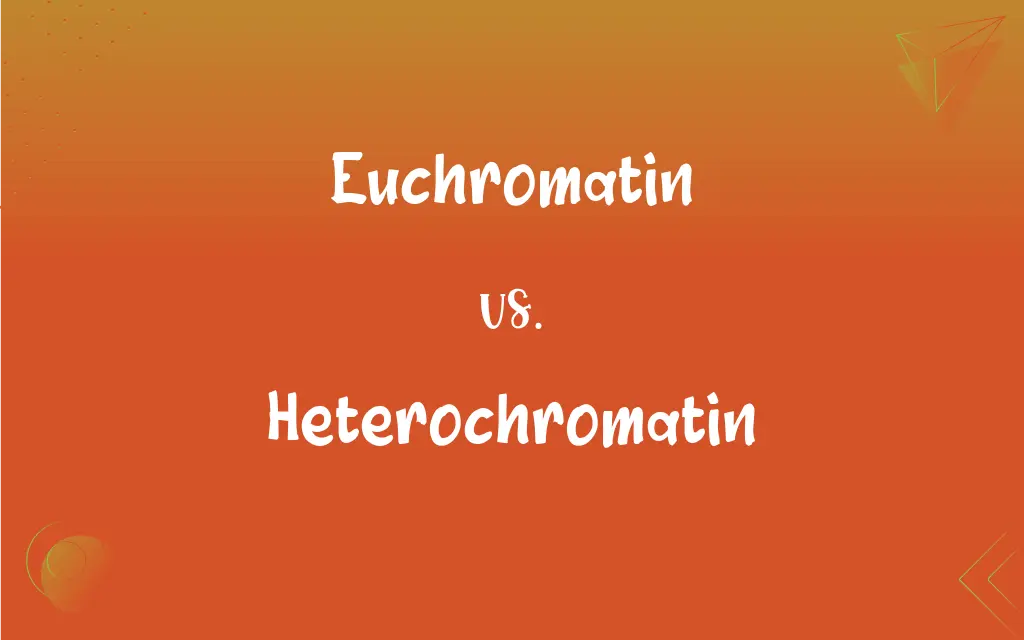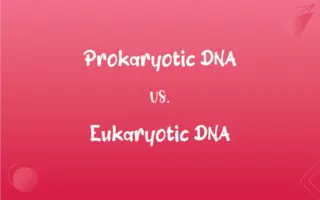Euchromatin vs. Heterochromatin: What's the Difference?
Edited by Janet White || By Harlon Moss || Updated on October 10, 2023
Euchromatin is loosely packed, transcriptionally active DNA; heterochromatin is tightly packed, mostly inactive DNA.

Key Differences
Euchromatin is considered to be the "active" form of chromatin because it is generally gene-rich and is involved in active transcription. Contrarily, heterochromatin is often referred to as the "silent" form of chromatin because it is usually transcriptionally inactive.
Euchromatin possesses a lighter appearance under a microscope due to its less condensed structure, making it accessible for the cellular machinery responsible for transcription. In contrast, heterochromatin appears darker because of its tightly packed structure, limiting gene expression.
Regions of euchromatin are subject to processes such as replication and repair more frequently than heterochromatin due to their active involvement in the cell’s metabolic activities. Heterochromatin, being mostly inactive, does not frequently undergo such processes.
Euchromatin plays a critical role in gene regulation by facilitating the binding of transcription factors and RNA polymerase to the DNA. Heterochromatin, due to its compact nature, typically inhibits binding, restricting gene expression.
While euchromatin is usually found throughout the nucleus, heterochromatin tends to be localized at the periphery of the nucleus, often associating with the nuclear envelope, thereby reflecting their respective active and repressive roles in gene expression.
ADVERTISEMENT
Comparison Chart
Grammatical Type
Noun
Noun
Syllables
Four (Eu-chro-ma-tin)
Four (Het-ero-chro-ma-tin)
Word Origin
Greek (eu- “true” + chromatin)
Greek (hetero- “different” + chromatin)
Use in Sentences
Usually used as a subject or object
Typically used as a subject or object
Related Terms
Chromatin, histones
Chromatin, nucleosome
ADVERTISEMENT
Euchromatin and Heterochromatin Definitions
Euchromatin
Euchromatin is the less condensed form of DNA that is transcriptionally active.
In cells, euchromatin regions are crucial for transcription and gene expression.
Heterochromatin
Heterochromatin can be constitutive or facultative, with constitutive being permanently inactive.
Constitutive heterochromatin is crucial for maintaining chromosome stability.
Euchromatin
Euchromatin is characterized by its lighter appearance under a microscope due to its loose packing.
Euchromatin regions, being less dense, appear lighter when observed microscopically.
Heterochromatin
Heterochromatin refers to densely packed DNA that is largely transcriptionally inactive.
Genes located in heterochromatin regions are typically not expressed due to the condensed structure.
Euchromatin
Euchromatin is often associated with gene-rich regions within the genome.
Scientists have associated euchromatin with active gene expression due to its accessibility.
Heterochromatin
Heterochromatin is often found at the periphery of the cell nucleus.
Heterochromatin localization near the nuclear envelope helps in structural maintenance of the nucleus.
Euchromatin
Euchromatin is dynamically changed and reshaped during cellular activities.
The structure of euchromatin is subject to modification during various cellular processes.
Heterochromatin
Heterochromatin appears darker under a microscope due to its tightly packed structure.
The dark areas observed in the cell nucleus under a microscope typically represent heterochromatin.
Euchromatin
Euchromatin plays a pivotal role in biological processes like DNA replication and repair.
Due to its loose structure, euchromatin facilitates processes like DNA repair and replication.
Heterochromatin
Heterochromatin is often associated with the suppression of gene expression.
In cellular biology, heterochromatin regions correlate with areas of reduced gene activity.
Euchromatin
Chromosomal material that is genetically active and stains lightly with basic dyes.
Heterochromatin
Tightly coiled chromosomal material that stains deeply during interphase and is believed to be genetically inactive.
Euchromatin
(genetics) uncoiled dispersed threads of chromosomal material that occurs during interphase; it stains lightly with basic dyes
Heterochromatin
(cytology) Heterochromatic tightly coiled chromosome material; believed to be genetically inactive
FAQs
Is heterochromatin always inactive in gene expression?
Not always; facultative heterochromatin can be transcriptionally active under certain circumstances.
Why does euchromatin appear lighter under a microscope?
Euchromatin appears lighter because its less condensed structure scatters light more diffusely.
How does the compactness of heterochromatin impact gene expression?
The compactness of heterochromatin generally inhibits gene expression by limiting access to the transcriptional machinery.
What is euchromatin?
Euchromatin is a loosely packed form of DNA that is generally transcriptionally active.
What is heterochromatin?
Heterochromatin refers to the densely packed, largely transcriptionally inactive DNA in a cell.
Can euchromatin affect phenotype expressions?
Yes, since euchromatin involves actively expressed genes, changes or mutations here can influence phenotype expressions.
What is the significance of euchromatin in gene regulation?
Euchromatin is crucial for gene regulation as its loose structure allows access to transcription machinery, enabling gene expression.
Why is heterochromatin often found at the periphery of the nucleus?
Heterochromatin is localized at the nuclear periphery to help maintain nuclear structure and repress genes that are not needed.
How do euchromatin and heterochromatin contribute to cellular differentiation?
Euchromatin and heterochromatin play pivotal roles in cellular differentiation by selectively activating or repressing genes, guiding the cell towards specific lineages.
Are there specific proteins associated with euchromatin and heterochromatin?
Yes, specific proteins, such as histones, are variably modified in euchromatin and heterochromatin to regulate chromatin structure and function.
How does heterochromatin contribute to chromosome stability?
Heterochromatin contributes to chromosome stability by providing structural integrity and protecting chromosome ends and centromeres.
How do cells manage the structural changes between euchromatin and heterochromatin?
Cells manage structural changes between euchromatin and heterochromatin through epigenetic modifications and chromatin remodeling complexes.
What are the roles of euchromatin and heterochromatin during DNA replication?
Euchromatin is actively involved in DNA replication due to its accessibility, while heterochromatin, due to its compactness, is less involved.
Can euchromatin and heterochromatin be visually differentiated in cells?
Yes, under a microscope, euchromatin appears lighter due to its loose structure, while heterochromatin appears darker due to its density.
Why is euchromatin crucial for DNA repair mechanisms?
Euchromatin, being loose and accessible, facilitates the engagement of DNA repair machinery, promoting efficient repair processes.
Can heterochromatin play a role in aging?
Yes, changes in heterochromatin structure and distribution have been associated with aging and age-related diseases in various studies.
Can genes within heterochromatin be activated?
Yes, genes in facultative heterochromatin can sometimes be activated under specific conditions or developmental stages.
Does euchromatin contain more genes than heterochromatin?
Generally, euchromatin is gene-rich, while heterochromatin is often gene-poor or contains inactive genes.
Where is euchromatin located in a cell?
Euchromatin is typically distributed throughout the nucleus of a cell.
Can euchromatin convert into heterochromatin?
Yes, euchromatin can convert into heterochromatin through processes like methylation, affecting gene expression.
About Author
Written by
Harlon MossHarlon is a seasoned quality moderator and accomplished content writer for Difference Wiki. An alumnus of the prestigious University of California, he earned his degree in Computer Science. Leveraging his academic background, Harlon brings a meticulous and informed perspective to his work, ensuring content accuracy and excellence.
Edited by
Janet WhiteJanet White has been an esteemed writer and blogger for Difference Wiki. Holding a Master's degree in Science and Medical Journalism from the prestigious Boston University, she has consistently demonstrated her expertise and passion for her field. When she's not immersed in her work, Janet relishes her time exercising, delving into a good book, and cherishing moments with friends and family.































































